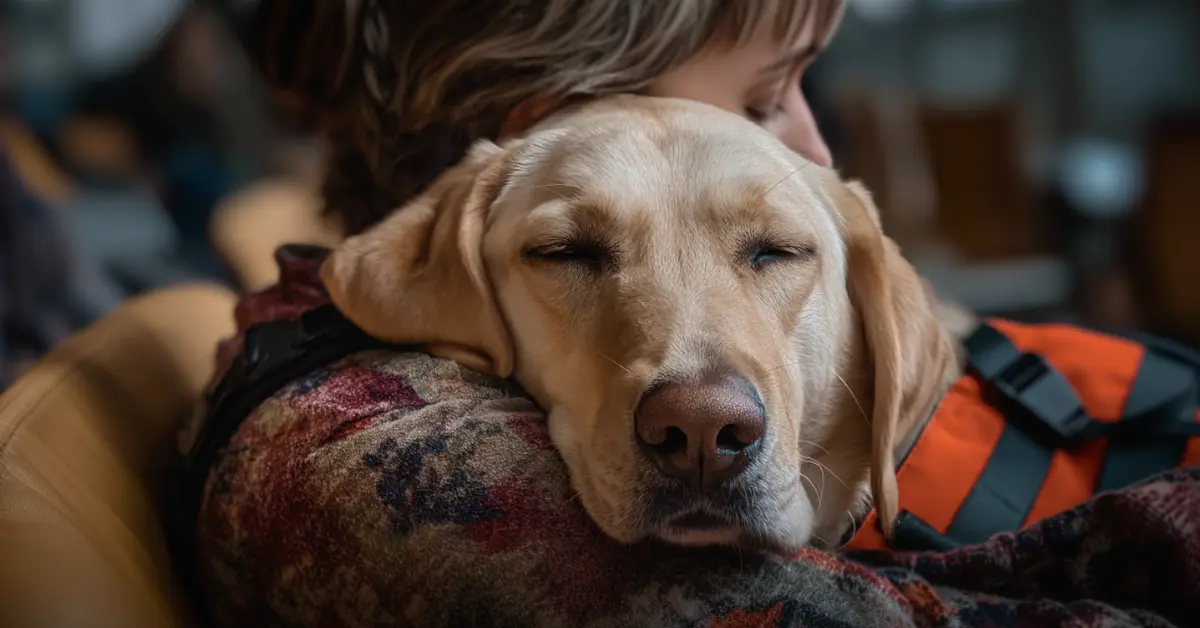How Dogs Stop Panic Attacks

When a panic attack hits, your heart races, chest tightens, and thoughts scramble, leaving you in a vulnerable state. Debilitating panic attacks can qualify as an ADA disability, and a psychiatric service dog can be trained to stop a panic attack by doing the following:
• Performing deep pressure therapy that switches your nervous system from panic mode to calm
• Detecting panic before it peaks and interrupting the cycle when you can still manage it
• Creating a safe space around you by blocking crowds or guiding you to exits
• Fetching emergency help, like medications or people, when you can’t think clearly
• Bringing you back to reality through gentle, persistent contact during severe episodes
Deep Pressure Therapy
Sarah felt her heartbeat quicken and her thoughts race as she sat on her couch at home, feeling the familiar symptoms of a panic spiral coming on. Rex, her Golden Retriever, immediately climbed onto her lap, pressing all 65 pounds against Sarah’s chest and legs to calm her down.
This is an example of a deep pressure therapy technique that can stop panic attacks by flipping a switch in your nervous system — your body goes from “fight or flight” to “rest and calm” as your heart rate drops and blood pressure falls, often within minutes.
Dogs can learn different pressure positions, like across your lap when sitting, against your back when standing, or on top of you if you’re lying down.
To learn more, check out our guide on how to train a dog for deep pressure therapy.
Early Alert and Interruption
When stress hits your body, it releases volatile organic compounds — chemical signals in your breath and sweat that dogs detect with remarkable precision. Research shows dogs can identify these stress chemicals with 93.75% accuracy, often sensing changes before you notice any symptoms.
Trainers can teach dogs to associate the scent of stress hormones with a specific alert behavior, like pawing, nudging, or positioning themselves in a particular way. The dog practices this response hundreds of times until it becomes automatic.
This early intervention works because you’re catching panic during the buildup phase, not fighting a full-blown attack. The physiological effects of panic (such as a racing heart, shallow breathing, and muscle tension) are much easier to interrupt when it’s just beginning rather than after it peaks.
Creating a Safe Space
Crowded spaces trigger panic through a primitive response in the brain. When your “personal space bubble” is invaded, your amygdala interprets this as danger and floods your system with stress hormones. Research shows people with anxiety have an exaggerated sense of personal space, making them feel trapped even when they’re not.
Your dog can counteract this by creating and controlling spatial boundaries around you. They can learn specific positioning techniques, called “crowd work,” through training that starts in quiet environments and gradually progresses to busy public spaces.
Dogs train for crowdwork by learning to position themselves between their handler and approaching people. The “block” command teaches them to stand parallel to you, creating a physical barrier. For “covering,” they learn to circle around you, forming a protective perimeter. Most importantly, they master “find exit” — locating and leading you to the nearest door when you get overwhelmed.
This spatial intervention works on multiple levels. Physically, it removes the trigger by restoring your personal space bubble. Psychologically, it gives you back control when everything feels chaotic. The sense of being trapped is central to claustrophobic panic, and when your dog ensures you always have an escape route and buffer zone, that trapped feeling can go away.
Emergency Assistance
During severe panic attacks, your body prioritizes survival over everything else. Your heart races past 115 beats per minute, and blood flow shifts away from your hands to your vital organs. Suddenly, your hands shake so badly you can’t open a pill bottle or dial a phone. Simple tasks become impossible.
This is where retrieval training saves lives. Dogs learn to fetch specific items through repetition and rewards, starting with easy tasks and building up to complex ones.
David’s Lab Mix Cooper shows how this works. Cooper learned to recognize David’s anxiety medication bottle by its shape, size, and smell. When David’s panic attacks hit, Cooper would open his backpack, identify the right bottle among several medications, and bring it directly to David along with water.
Service dogs can even learn emergency tasks like pressing large buttons to activate medical alerts, finding family members in the house and bringing them back, or opening doors for paramedics.
Grounding and Refocusing
Panic can make you feel like you’re floating outside your body. Nothing seems real. Your service dog can bring you back with gentle, persistent contact.
This isn’t the same as pressure therapy. Grounding is lighter but steady. Your dog might lick your hands repeatedly. Paw gently at your arms. Rest their head on your feet. The goal is to give you something real to focus on.
Raya’s Golden Doodle Finn knew when Raya was dissociating. She’d get a blank, distant look. Stop responding to people.
Finn’s job was bringing Raya back. He’d start by licking her hands. If that didn’t work, he’d paw her arms or legs. He kept making gentle contact until Raya responded.
The physical sensation of Finn’s tongue or paws gave Raya something concrete to focus on. Instead of being lost in panic, she could feel his warm nose or soft fur.
This technique works because it engages your senses. When your mind races with panicky thoughts, focusing on physical feelings can break the cycle.
Click on the link for more information on training your dog for grounding tasks.
This article is for informational purposes only and is not intended as medical advice. If you are experiencing panic attacks or other mental health symptoms, please consult with a qualified healthcare professional.
About the Author: The writing team at Service Dog Certifications is made up of folks who really know their stuff when it comes to disability laws and assistance animals. Many of our writers and editors have service dogs themselves and share insights from their own experiences. All of us have a passion for disability rights and animals.
Related Articles

How Dogs Can Calm Anxiety
A person suffering from anxiety attacks experience many risks, and it’s one of the reasons why it’s prudent to consider having a service dog or emotional support animal as a companion. The animal can keep the environment safer for the individual and below are some of the ways a dogs can calm anxiety: 1) Dogs […]

Read More

Service Dogs for PTSD
Service dogs for mental health, known as psychiatric service dogs (PSD), can help certain people with post-traumatic stress disorder (PTSD). A PTSD service dog can legally accompany their handler in areas open to the public, residential buildings that ban pets, and on airplanes. In this article, we will explain how a service dog can assist […]

Read More

Everything to Know about Diabetic Service Dogs
A diabetic service dog can smell when your blood sugar levels are getting dangerously high or low. These dogs are trained to let you know when your blood sugar has spiked too high or dropped too low, so you can take action before the problem turns into a medical emergency. Unlike service dogs that help […]

Read More